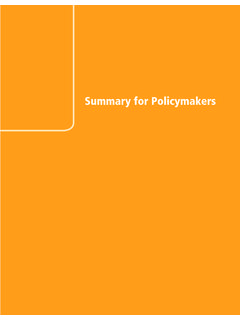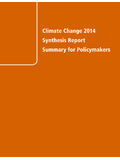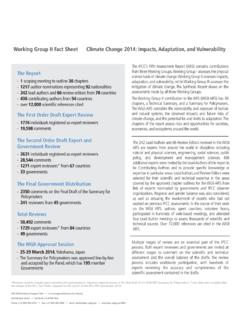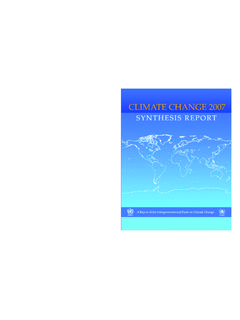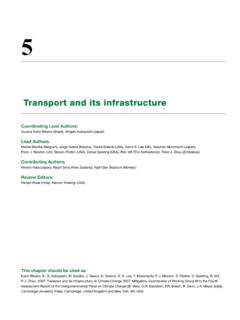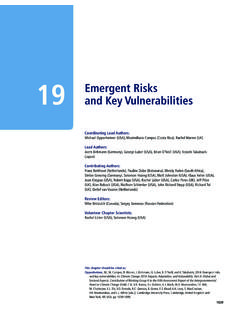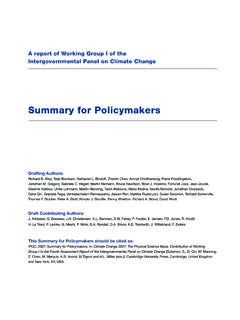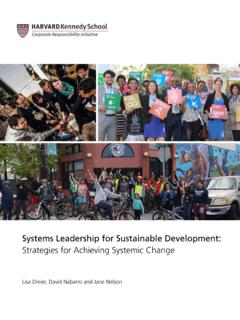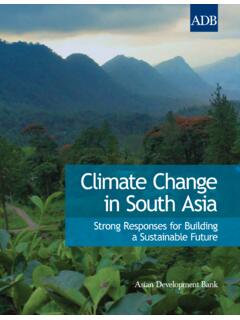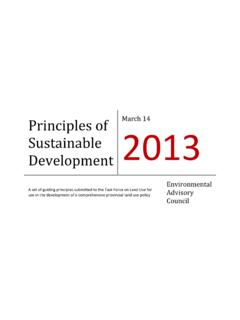Transcription of 1 Renewable Energy and Climate Change
1 1611 Renewable Energy andClimate ChangeCoordinating Lead Authors:William Moomaw (USA), Francis Yamba (Zambia)Lead Authors:Masayuki Kamimoto (Japan), Lourdes Maurice (USA), John Nyboer (Canada), Kevin Urama (Kenya/Nigeria), Tony Weir (Fiji/Australia)Contributing Authors:Thomas Bruckner (Germany), Arnulf J ger-Waldau (Italy/Germany), Volker Krey (Austria/Germany), Ralph Sims (New Zealand), Jan Steckel (Germany), Michael Sterner (Germany), Russell Stratton (USA), Aviel Verbruggen (Belgium), Ryan Wiser (USA)Review Editors: Jiahua Pan (China) and Jean-Pascal van Ypersele (Belgium)This chapter should be cited as:Moomaw, W., F. Yamba, M. Kamimoto, L. Maurice, J. Nyboer, K. Urama, T. Weir, 2011: Introduction. In IPCC Special Report on Renewable Energy Sources and Climate Change Mitigation [O. Edenhofer, R. Pichs-Madruga, Y. Sokona, K. Seyboth, P. Matschoss, S. Kadner, T. Zwickel, P. Eickemeier, G. Hansen, S. Schl mer, Stechow (eds)], Cambridge University Press, Cambridge, United Kingdom and New York, NY, Energy and Climate ChangeChapter 1 Table of ContentsExecutive Summary.
2 Background .. Introduction .. The Special Report on Renewable Energy Sources and Climate Change Mitigation .. Climate Change .. Drivers of carbon dioxide emissions .. Renewable Energy as an option to mitigate Climate Change .. Options for mitigation .. Trends in international policy on Renewable Energy .. Advancing knowledge about Renewable Energy .. Metrics and defi nitions .. Summary of Renewable Energy resources .. Defi nition, conversion and application of Renewable Energy .. Theoretical potential of Renewable Energy .. Technical potential of Renewable Energy technologies .. Special features of Renewable Energy with regard to integration .. Energy effi ciency and Renewable Energy .. Meeting Energy service needs and current status .. Current Renewable Energy fl ows .. Current cost of Renewable Energy .. Regional aspects of Renewable Energy .
3 190163 Chapter 1 Renewable Energy and Climate Opportunities, barriers and issues .. Opportunities .. Social and economic development .. Energy access .. Energy security .. Climate Change mitigation and reduction of environmental and health impacts .. Barriers .. Market failures and economic barriers .. Informational and awareness barriers .. Socio-cultural barriers .. Institutional and policy barriers .. Issues .. Role of policy, research and development , deployment, scaling up and implementation strategies .. Policy options: trends, experience and assessment .. Enabling environment .. Complementing Renewable Energy policies and .. 199 non- Renewable Energy policies .. Providing infrastructure, networks and markets for Renewable Energy .. A structural shift .. 199 References .. 200 Appendix to Chapter 1 .. 206164 Renewable Energy and Climate ChangeChapter 1 Executive SummaryAll societies require Energy services to meet basic human needs ( , lighting, cooking, space comfort, mobility, communication) and to serve productive processes.
4 For development to be sustainable , delivery of Energy services needs to be secure and have low environmental impacts. sustainable social and economic development requires assured and affordable access to the Energy resources necessary to provide essential and sustainable Energy services. This may mean the application of different strategies at different stages of economic development . To be envi-ronmentally benign, Energy services must be provided with low environmental impacts and low greenhouse gas (GHG) emissions. However, 85% of current primary Energy driving global economies comes from the combustion of fossil fuels and consumption of fossil fuels accounts for of all anthropogenic GHG emissions. Renewable Energy sources play a role in providing Energy services in a sustainable manner and, in particu-lar, in mitigating Climate Change . This Special Report on Renewable Energy Sources and Climate Change Mitigation explores the current contribution and potential of Renewable Energy (RE) sources to provide Energy services for a sus-tainable social and economic development path.
5 It includes assessments of available RE resources and technologies, costs and co-benefi ts, barriers to up-scaling and integration requirements, future scenarios and policy options. GHG emissions associated with the provision of Energy services are a major cause of Climate Change . The IPCC Fourth Assessment Report (AR4) concluded that Most of the observed increase in global average temperature since the mid-20th century is very likely due to the observed increase in anthropogenic greenhouse gas concentrations. Concentrations of CO2 have continued to grow and by the end of 2010 had reached 390 ppm CO2 or 39% above pre-industrial levels. The long-term baseline scenarios reviewed for the AR4 show that the expected decrease in the Energy intensity will not be able to compensate for the effects of the projected increase in the global gross domes-tic product. As a result, most of the scenarios exhibit a strong increase in primary Energy supply throughout this century.
6 In the absence of any Climate policy, the overwhelming majority of the baseline scenarios exhibit considerably higher emissions in 2100 compared to 2000, implying rising CO2 concentrations and, in turn, enhanced global warming. Depending on the underlying socioeconomic scenarios and taking into account additional uncertainties, global mean temperature is expected to rise and to approach a level between C and C over the 1980 to 1999 average by the end of this century. To avoid adverse impacts of such Climate Change on water resources, ecosystems, food security, human health and coastal settlements with potentially irreversible abrupt changes in the Climate system, the Cancun Agreements call for limiting global average temperature rises to no more than 2 C above pre-industrial values, and agreed to consider limiting this rise to C. In order to be confi dent of achieving an equilibrium temperature increase of only 2 C to C, GHG concentrations would need to be stabilized in the range of 445 to 490 ppm CO2eq in the atmosphere.
7 There are multiple means for lowering GHG emissions from the Energy system, while still providing desired Energy services. RE technologies are diverse and can serve the full range of Energy service needs. Various types of RE can supply electricity, thermal Energy and mechanical Energy , as well as produce fuels that are able to satisfy multiple Energy service needs. RE is any form of Energy from solar, geophysical or biological sources that is replenished by natural processes at a rate that equals or exceeds its rate of use. Unlike fossil fuels, most forms of RE produce little or no CO2 contribution RE will provide within the portfolio of low carbon technologies heavily depends on the economic competition between these technologies, their relative environmental burden (beyond Climate Change ), as well as on security and societal aspects. A comprehensive evaluation of any portfolio of mitigation options would involve an evaluation of their respective mitigation potential as well as all associated risks, costs and their contribution to sustainable development .
8 Even without a push for Climate Change mitigation, scenarios that are 165 Chapter 1 Renewable Energy and Climate Changeexamined in this report fi nd that the increasing demand for Energy services is expected to drive RE to levels exceeding today s Energy a global basis, it is estimated that RE accounted for of the total 492 EJ of primary Energy supply in 2008. The largest RE contributor was biomass ( ), with the majority (roughly 60%) of the biomass fuel used in traditional cooking and heating applications in developing countries but with rapidly increasing use of modern bio-mass as Hydropower represented , whereas other RE sources accounted for In 2008, RE contributed approximately 19% of global electricity supply (16% hydropower, 3% other RE), biofuels contributed 2% of global road transport fuel supply, and traditional biomass (17%), modern biomass (8%), solar thermal and geothermal Energy (2%) together fuelled 27% of the total global demand for heat.
9 The contribution of RE to primary Energy supply varies substantially by country and region. Scenarios of future low greenhouse gas futures consider RE and RE in combination with nuclear, and coal and natural gas with carbon capture and the RE share of global Energy consumption is still relatively small, deployment of RE has been increas-ing rapidly in recent years. Of the approximately 300 GW of new electricity generating capacity added globally over the two-year period from 2008 to 2009, 140 GW came from RE additions. Collectively, developing countries hosted 53% of global RE power generation capacity in 2009. Under most conditions, increasing the share of RE in the Energy mix will require policies to stimulate changes in the Energy system. Government policy, the declining cost of many RE technologies, changes in the prices of fossil fuels and other factors have supported the continuing increase in the use of RE. These developments suggest the possibility that RE could play a much more prominent role in both developed and developing countries over the coming RE technologies can be deployed at the point of use (decentralized) in rural and urban environments, whereas others are primarily employed within large (centralized) Energy networks.
10 Though many RE tech-nologies are technically mature and are being deployed at signifi cant scale, others are in an earlier phase of technical maturity and commercial theoretical potential for RE greatly exceeds all the Energy that is used by all economies on Earth. The global technical potential of RE sources will also not limit continued market growth. A wide range of estimates are provided in the literature but studies have consistently found that the total global technical potential for RE is substan-tially higher than both current and projected future global Energy demand. The technical potential for solar Energy is the highest among the RE sources, but substantial technical potential exists for all forms of RE. The absolute size of the global technical potential for RE as a whole is unlikely to constrain RE RE, including wind and solar power, are variable and may not always be available for dispatch when needed. The Energy density of some RE is also relatively lower, so that reducing the delivered Energy needed to supply end-use Energy services is especially important for RE even though benefi ting all forms of levelized cost of Energy for many RE technologies is currently higher than existing Energy prices, though in various settings RE is already economically competitive.
